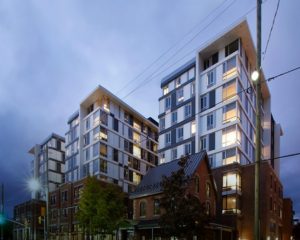The rental market is surging across Canada with limited supply in key markets contributing to the sky-high cost of rent. For post-secondary students kicking off the fall semester, a lack of student housing combined with the punitive cost of living, has added more pressure to the pursuit of higher education. Reports from across Canada have been largely grim, with many claiming they’ve struggled to find suitable, affordable accommodations in and around campuses. And where most colleges and universities once guaranteed on-campus housing for all incoming first-year students, long waitlists are becoming the norm as more second-year students opt to remain in residence due to the lack of alternatives.
“The shortage of student housing has definitely been highlighted as a large issue across the country for the 2022/23 academic year,” says Trish MacPherson, partner at Alignvest Student Housing. “Essentially, Canada is still behind where it should be. Both the private and public sectors need to make housing a top priority if we are going to remain a top domestic and international destination for higher education.”
Underscoring her point, MacPherson references a 2021 study that places Canada’s provisioning rate—the percentage of full-time students in off-campus student housing beds—at just 3 per cent. Meanwhile, in more developed markets like the U.S. and U.K., provisioning rates are above 10 and 17 per cent respectively.

“The Annex” student housing building in Ottawa, owned and operated by Alignvest Student Housing.
Off-campus PBSA establishments typically range from smaller buildings with a few dozen rooms, to large-scale developments that cater to 1,000-plus students. Suites often have up to six bedrooms, with residents sharing common kitchens and bathrooms. On-site amenities run the gamut from games rooms, gyms, quiet study spaces, and party lounges, making these buildings a popular option for parents and students alike. For Canadian colleges and universities constrained by limited funding and long waitlists for on-campus housing, there is an increasing reliance on the PBSA sector to offset housing need, as soaring rents and historically low vacancy rates squeeze students out of the broader rental market.
“A housing crisis for students”
Calling this “a housing crisis for students,” the Canadian Federation of Students (CFS) and other groups say the rapid expansion of international student enrollment is the main reason supply is so urgently needed. According to Statistics Canada, there were 2,183,973 students enrolled in Canadian post-secondary institutions during the 2019/20 academic year—of which 18 per cent were international. Meanwhile, a recent Cushman & Wakefield report on Canada’s student housing sector indicates that international student enrollment has increased by more than 12 per cent annually throughout the past decade. By contrast, the annual average rate of growth for domestic students was -0.2 per cent, and for this reason, Cushman & Wakefield calls international student enrollment “the primary catalyst for the establishment of the purpose-built student residence market in Canada.”
The good news is universities and private companies are working towards furthering the goal of bringing more off-campus student-geared properties to market, just as several new residences are opening at campuses across Canada. With an impressive 21,000 new residence spaces feeding into the 24 largest student markets by 2025, a 15 per cent increase in total beds is expected.
At McMaster University in Hamilton, two new residences are underway, bringing 2,000 new beds to campus by 2024. In BC, an eight-storey student housing building with 385 beds just opened at the University of Victoria (UVic), offering more living arrangements in a city with one of the lowest rental vacancy rates in the province. At Queen’s University in Kingston, a new residence is set to open this year bringing more than 330 additional beds to campus. The University of Toronto, University of Windsor and Carleton University are also in the process of building new residences to offset some of the projected need.
The question remains, will it be enough? Time will tell, but for those still seeking affordable student housing near their chosen campuses this fall, it sure isn’t coming fast enough.
Highlights from the report:
- Total university-owned (on-campus) and privately-owned (off-campus) housing provide about 145,000 beds in the 24 markets surveyed, which represents about 15% of total full-time students. Of this total, about 45,000 beds are located in privately-owned, off-campus student residences.
- Comparatively, RealPage reported that U.S. student housing bed supply equated to about 40% of total student enrollments in 2020/21. In the U.K., total bed supply is estimated to make up about 35% of student enrollments. This would indicate that there remains strong investment opportunity in Canada for new student residence development.
- In terms of new supply in Canada, Cushman & Wakefield identified approximately 21,000 beds currently in the development pipeline for both university-owned and privately-owned student properties, which are expected to be completed between 2022 and 2025.
For more information of PBSAs and the state of Canada’s student housing sector, click here: Canadian Student Housing Outlook 2022 | Canada | Cushman & Wakefield (cushmanwakefield.com)






